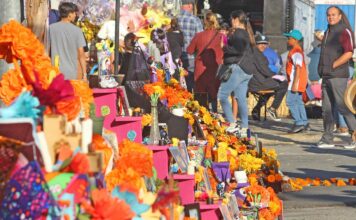It’s more complicated than moving the children’s play area or
relocating the beer tents, but Garlic Festival Association
officials assure residents that however quickly (or slowly) their
downtown condominiums sell, the festival remains safe.
It’s more complicated than moving the children’s play area or relocating the beer tents, but Garlic Festival Association officials assure residents that however quickly (or slowly) their downtown condominiums sell, the festival remains safe.
This month the nonprofit association will begin selling the 24 condos above its new office space at 7600 Monterey St. Pending successful sales that begin in the low $300,000 range, the GFA will split any gains evenly with its for-profit partner, Tanglewood Construction, and then reinvest its share back into the nonprofit itself. Past festival past presidents will allocate – like they do every year after the festival – a significant portion of any profits to local charities.
But the festival’s board of directors did not plan on a sour housing market when it voted in August 2005 to add the residential portion to its new three-story building. Prescient thinking and careful planning in every other area, however, mean the condo venture’s financial repercussions will not affect the self-sustaining festival, said past and present officials. Plus, they added, the building will benefit the downtown in the long run no matter how dismal the housing market is now.
video tour of the condos
photo gallery of the construction effort
the progress of the building effort
“Hindsight is always 20-20, but the building is still a wonderful idea,” said 2003 GFA President Janie Mardesich. “The Garlic Festival never went into the real estate business, but unfortunately that’s become the focus.”
GFA Executive Director Brian Bowe stressed earlier this week that the GFA and Tanglewood have the summer and fall seasons to sell their condos without having to pay further interest on their construction loan. The money used to finance the festival’s half of the project – about $800,000 – came from a separate coffer the GFA created after selling its office space in its current building and the parking lot behind it, which the city bought in September 2005. The city, in turn, sold its 63-space parking lot at 7600 Monterey St. to the festival and gave the nonprofit $390,000 to offset the price difference between the two properties. The rest of the $800,000 came from the festival’s main account.
“What profits, if any, at the end of the day won’t be known for a very long time until this thing is said and done,” said Bowe, adding that the vast majority of revenue will pay back the construction loan and that the project was never about making money.
“This building project is entirely separate from the festival and its success,” Bowe said. “The 30th-annual festival will be successful and self-sufficient like it’s always been. There’s no reason to believe anything other than that.”
Bowe came on board in February 2006, six months after the nine-member GFA Board of Directors voted 6-0 – with one abstention and two members absent – to approve the condo component of the building project. To avoid conflict of interest, then-Director Jeff Martin abstained because he represented the festival and Tanglewood in what he termed his pursuit to fulfill former Executive Director Richard Nicholls’ vision of the new building. After 20 years on the job, Nicholls died of cancer in June 2005, a month before the festival occurred, so the board was naturally coping with this news, as well, Bowe said.
Throughout that time, the festival’s 2005 board of directors, led by then-President Jennifer Speno, spent months debating whether the residential element was a good idea. There were some slight skeptics who initially called for more prudence, but then the group studied the idea, consulted with lawyers and took pains to make sure the funds for the condominium venture would not take any away from the charities, said Speno and several former board members.
“We had several meetings wondering if this was the right avenue to take,” Speno said. “It’s unfortunate the way the housing market is going, but in 2005, with all the details we had, this was an opportunity we could not pass up … Years from now, when the housing crunch is gone, that building will still be there and will still be an improvement for the city of Gilroy.”
The festival initially planned to buy a smaller office building on Eigleberry Street when it decided to move, but Bowe and Martin said Community Development Director Wendie Rooney really urged the multi-use idea with the condos.
“We took a large leap of faith with Wendie (Rooney) prodding us,” said Martin, adding that about $400,000 in downtown fee waivers made the larger, multi-use project an attractive option. “It was the perfect storm,” Martin said.
“When Wendie Rooney came into the picture, and the city was offering incentives – all those things made the idea very attractive,” echoed Speno. Rooney was out of town and could not be reached for comment.
2005 Vice President and 2006 President Micki Pirozzoli emphasized the gulf between the festival – led by Bowe – and the real estate side, led by others such as Martin, Tanglewood, the Ryness Company (a marketing firm) and 1999 festival President and current Festival Members Representative Randy Costa.
“There were always the ‘What ifs?’ and ‘What will the public think?’ but the conversation always came back to the fact that any profits made would go back into the Garlic Festival, which goes into running it, and then that money goes back into the community,” Pirozzoli said. “There was a lot of conversation about how this would be perceived, but we never looked at it as a money-maker; we just needed a new building.”













